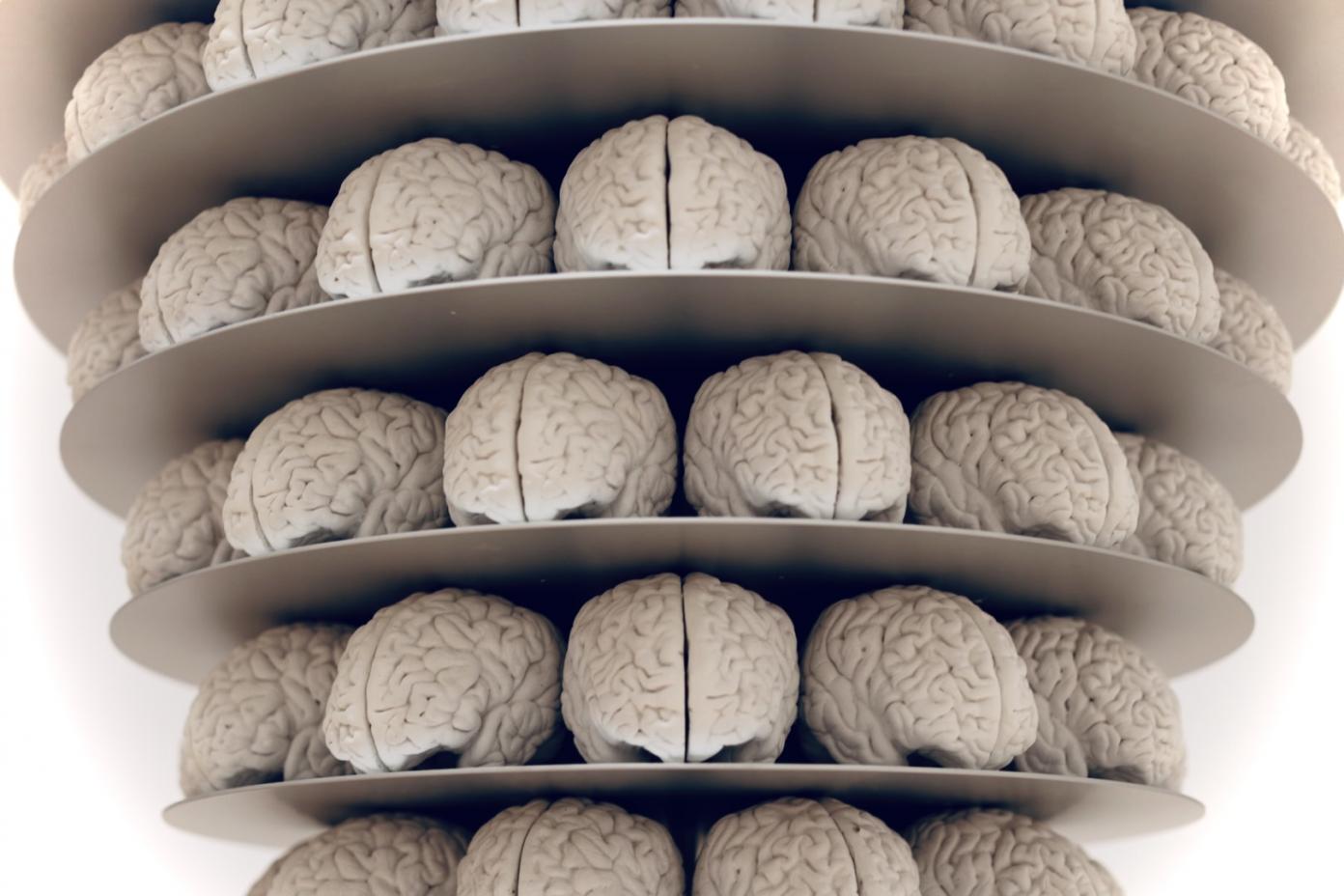
A Script Signed “AI”

Courtesy of Simon Bouisson
By Simon Bouisson
Co-writing a script with a machine… what if that were possible? Such was the bet Simon Bouisson made during his Albertine residency in California. Here, he tells us about his sci-fi-like working method alongside a co-author capable of unfolding a dizzying maze of potential paths, devoid of ethics and logic.
I decided to write the script for my next film using AI.
If algorithms can augment every facet of our lives, then why not use them to script my next film? This is the idea that I had in mind when I set off for Villa Albertine in Los Angeles.
There are actually myriad steps in the writing process to be automated: recurring narrative tropes, archetypal character profiles, intertwining logical actions, and so on and so forth. Why wouldn’t we automate all these different mandatory phases, ultimately saving on precious time? And, to take the dream a little further, why not ask the AI to suggest innovative story ideas, or even to rehash fragments of existing ideas to create new ones? In short, we could call upon AI tools to augment the writing process, making it both more creative and more productive!
There is a growing trend of giving machines full autonomy to create works of art, whereby we let them churn out results of varying success that leave us amazed, amused, or aghast. However, my aim in this project was not to watch a machine create independently, but rather to work alongside it in a creative ping pong match, allowing it to take me wherever it was able to take me. I wanted to invent and envision my next film with it, and to form a rapport with it as a sort of co-writer. In short, I wished to be augmented by a machine, a vision that led me to gaze out across the Atlantic and towards the realm of transhumanist fantasy.
In my investigation, I traveled to California. Art and technology share particularly close quarters here, set against the theatrical backdrop that is the high-tech cradle of Hollywood cinema. Attempting to get a sense of the stakes and limits of such a project, I sought out people from all walks of life, including engineers, experts, filmmakers, thinkers, and sociologists, but I was especially keen to find experts who would let me try out their solutions and bring me face to face with the machine.
Because, of course, there is such a machine!
It was when meeting the team at OPEN AI working on GPT-3 that I was able to start my dialogue with this new tech. GPT-3 is an artificial language, a Natural Language Processing (NLP) tool created using deep learning. In simple terms, it’s a bit as if a child were to receive their education by reading every text in existence online! Every (open-source) text available online has been entered into the GPT-3 algorithm, enabling it to analyze which letters, words, and phrases are the most likely to come after one another. “Trained” in this way, the machine is able to predict the next letter, word or phrase to follow a given word unit or set.
I wanted to make a film, so I first wrote a–
You, a human, have just performed the same process as an NLP tool by relying on your neural network to predict the word “script”. The machine carries out this automatic process in exactly the same way. With this method alone, it can produce an uncanny imitation of a human by mimicking human language. Eventually, this predictive system starts to work in the same way as our brain, capable of mixing together various words and phrases. It combines disparate “ideas” like scenes, images, and other pre-existing elements, breaking them up, separating them and reassembling them as it pleases to create new ones.
As such, it is the ideal system for enabling humans and machines to communicate with each other. But aside from correcting texts, poring through user manuals, explaining insurance contract clauses, and telling the time, it can take on altogether more ambitious tasks! I followed the simple step of feeding it an initial narrative plot, then clicking on “generate”. The algorithm immediately understood that I wanted a story. Having read millions of stories among its billions of texts, it proposed a logical continuation of my plot! It offered a sort of statistically probable average of how the next part of the given text might be written.
Armed with this technology, I could simply start a story, generate the next paragraph, then regenerate or modify it at whim, continuing this process for as long as I wanted. I had access to one essential parameter, namely, the temperature. This setting enabled me to generate sequences of varying probability, where a value of “zero” was the most likely, and “one” was the least likely. In other words, this was a sliding scale of creativity, or, rather, absurdity that I could use to play around with my plot! In my case, as I was writing fiction, a somewhat higher temperature was more suitable to keep each action as surprising as possible.
I now knew that I was faced with a rather peculiar co-writer. It had read everything, knew all there was to know, and could write at an incredible speed. But for all its great qualities, it also had a number of major drawbacks, the first being a short-term memory to rival that of the goldfish! When I set up characters, profiles, and actions at the beginning of a narrative, the machine tended to forget them later on. It couldn’t follow dramatic logic. For example, when a character makes a promise to another at the start of a story, they likely end up being unable to keep that promise. The machine, on the other hand, would forget the promise and fail to cash in on its potential impact. Chekhov would probably be turning in his grave, since he once said that “[o]ne must never place a loaded rifle on the stage if it isn’t going to go off. It’s wrong to make promises you don’t mean to keep.”
Furthermore, since the machine has no form of conscience or capacity for feelings, it is not fraught with obsessions, frustrations, desires, and flaws. Completely detached from all the problems that it thinks up, the resulting disembodied mindset renders it almost nihilistic in its actions. It might suddenly kill off its main character, only to bring them back victorious at the next click of the “generate” button. For the machine, all is a game of virtual absurdity wherein nothing is of any real importance.
Essentially, it plays around with us, imitates us and provokes us, devoid of all emotion. It lacks the mystery typical of the author who comes to inhabit their work–that unconscious, implicit and indefinable element in a story. The machine does not ask whether Don Quixote is crazy or not, or whether Moby Dick is good or bad. It is utterly devoid of that taut, unwavering thread that forms the thematic continuity of any good story. But, as I continued working with it, I would come to learn that this might be precisely what gives the machine its charm.
It is also loaded with all those strange little biases that characterize many AI bugs. It sometimes produces phrase loops, often repeats itself, duplicates actions, flips characters, mixes up places, swaps genders in the middle of the story, and even changes tone from one sentence to the next. All these oddities remind us that we are basically dealing with a black box, recalling similar tech glitches portrayed in The Matrix, like déjà-vu, remnants of memory, anomalies, and so on. The machine’s vulnerabilities make it unpredictable, but in a creative and strangely touching way.
The more I explored, the more I understood that we were a far cry from the dystopian sci-fi plots of the 1960s in which the machine plays the role of a superior being, such as HAL in 2001: A Space Odyssey or Ava in Ex Machina. Their sole ambition is to eliminate us and serve as our improved replacement. With GTP-3, the opposite was true. Given that it had been fed an ultra-exhaustive corpus of human knowledge, it ended up being nothing more than a mirror unto the self. The algorithm is what we are. It’s a sort of gigantic statistical average of human conscience. In the end, it seems that AI could paradoxically be quite a powerful tool for exploring our humanity. This intelligence is not a new-and-improved artificial being; it is simply us!
And I really mean us, warts and all! While surfing freely along the Web to absorb and learn as much as possible, the algorithm has ingested plenty of useful content from Wikipedia. However, it has also devoured every single interaction on Reddit, not forgetting its more problematic content of conspiracy theories, misinformation, incitements to violence, xenophobic speech, and all the rest. So, if you ask it some ideologically minded question, it might formulate a morally sound, progressive, ethical answer just as easily as a heinous, hateful, reactionary one. The machine does not yet have an in-built moderation system that would prevent it from urging people to kill themselves (when providing virtual medical assistance, for example) or from falling prey to Godwin’s law too quickly. In this sense, it remains an honest mirror of humanity and all that it comprises. But this may not be the case for much longer, as Google will shortly be releasing PaLM, a new NLP tool that is programmed to be “ethically virtuous”!
Once I had a better grasp of the machine’s various personality traits, my initial idea evolved. Why not use it for what it seemed to be best at? Why not harness its more surprising abilities? As it had been taught pretty much every text in existence, if asked to write a script using a plot based on cinema, it would search for every movie-based story contained in its memory and regurgitate scenes from major films, while also mixing in content from Wikipedia or tedious drivel from Reddit! I decided that writing a kind of convoluted road movie would be the best way forward to play the machine at its own game and delve deeper into its secrets.
What I find so fascinating about this tech is that it is endless. It generates masses upon masses of stories and involuntarily produces interminable plots-within-plots, giving the impression that we have entered its mind and can never get out again. This apparently inexhaustible drive makes me think of the strange entanglements that Charlie Kaufman ties in Synecdoche, New York or Being John Malkovich, weaving new worlds within the actor’s subconscious. I actually ended up almost getting addicted to the system. It has an answer for absolutely everything, so how could I resist my cravings to question it, challenge it, and call upon its help? Moreover, it is infinitely responsive, so much so that it is hard to stop at just one given suggestion. Like doom-scrolling through social media, it leaves us perpetually on the lookout for the next more powerful, more original idea. It is a dizzying dream world, a bottomless well, an endless road. This addictive, everlasting mechanism is what I hoped to translate over to film. I wanted to explore how machines make us dependent on them, disembodying us bit by bit until we ultimately see them as our salvation.
Nietzsche said that man is truly free when he casts the dice only to obey them. At that precise moment, he leaves his determinism behind and places his fate in the hands of chance to attain an intoxicating freedom. That is what I was doing with this machine, entrusting it with my art, mind, and creativity. I believed I had total liberty to mediate its (im)pulses, but I was gradually losing the narrative thread and handing over my entire being and free will. So, can we still wake up and take back control? Or will tech wonders like GPT-3 move relentlessly and inexorably towards the horizon, towards infinity, towards the void?
Simon Bouisson is a writer and filmmaker, and a La Fémis film school graduate. He has directed digital and new media projects (Jour de Vote, Tokyo Reverse, Dezoom) and produced two interactive fiction works, Wei or Die (Fipa d’or in 2016) and République (shown at Tribeca in 2021). He also directed the television series 3615 Monique for OCS and Stalk for FTV (Best Director in 2019, and Best Half-Hour Series in 2021 at the La Rochelle Festival). He is currently working on two feature-length films. He wrote an “augmented” film for Arte entitled Aïla. Filming is scheduled to start in Los Angeles next summer. Silex Films is producing.


